|
Books by
Jeffery Robenalt
|
|
|
Walker
County, Texas, was originally named for
Mississippi legislator Robert J. Walker, the Congressman responsible
for introducing into the United States Congress the resolution to
annex Texas. Unfortunately for Congressman
Walker, he later fell out of favor with the residents of Huntsville
and the surrounding county when he supported the Union during the
Civil War. Reluctant to change the name of their county, residents
searched for another, more suitable Walker and decided to rename
the county for Texas Ranger Sam Walker. Looking down on the scene
from his place in Ranger heaven, Sam was sure to have been both
honored and amused.
|
|
Samuel
Hamilton Walker was born in Prince George County, Maryland in 1815,
and died during the Mexican American War in 1847, at the small Mexican
town of Huamantla. Thirty-two years is not a long life as measured
against most men, but Sam Walker’s brief years were an epic adventure
filled with Indian battles, wars, public renown, and honor; not
to mention being credited with assisting in the design of a revolver
that has forever carried his name and altered the concept of side
arms.
Little is known of Sam Walker’s early years, but it could be said
that his adventures began when he enlisted in the United States
Army in May 1836, to fight in Florida against Chief Osceola’s Seminole
Indians. During the fighting, Walker was promoted to corporal for
“exceptional courage” in the Battle of Hacheeluski. Mustered out
of the army in 1838, he eventually ended up in Galveston,
Texas, in January 1842, after a stint in Florida working for
a friend in railroad construction.
|
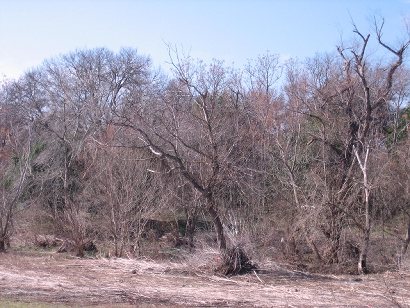 |
|
Several months
later Sam joined the Bastrop
militia and participated in the Battle
of Salado Creek, where a small group of volunteers, militia,
and Texas Rangers defeated a much larger Mexican force under the
command of French mercenary General Adrian Woll. After the defeat
of Woll, Walker’s militia company joined with a small unit of Texas
Rangers and for the first time Sam found himself under the command
of Jack Hays. The Texans pursued the Mexicans as they retreated
toward the Rio Grande, but heavily outnumbered, they had little
choice except to return to San
Antonio after a few minor skirmishes.
In retaliation for Mexico's incursion, the President of the Republic
of Texas, Sam Houston,
commissioned General Alexander Somervell to undertake a punitive
expedition. Somervell was also granted discretionary authority to
cross the Rio Grande. Sam Walker was one of the first privates to
sign up for the expedition.
Somervell’s 750 man army arrived at the Rio Grande on the morning
of December 8, capturing Laredo
without a fight. During the march south there had been a general
lack of discipline, but the problem grew worse when some of the
men left camp without authority and looted Laredo.
In light of the discipline problems and lack of supplies, General
Somervell elected to abandon the mission and return to San
Antonio on December 18. Not everyone agreed with this decision.
Nearly 300 men, Sam Walker among them, voted to quit the expedition,
electing William Fisher as their new commander.
On December 23, the small Texas army crossed the Rio Grande and
marched on the border town of Mier, defended by 3000 Mexican troops
under the command of General Pedro Ampudia. Disregarding odds of
more than ten to one, the Texans launched an attack and nearly succeeded
until they ran low on powder and ball and were forced to surrender.
Ampudia marched
the Texans south to rancho Salado where, led by Sam Walker, they
overwhelmed their guards and escaped. Unfortunately, the escapees
became lost in the mountainous desert north of Salado and 176 were
recaptured and sentenced to death by Santa Anna. Thanks to the good
auspices of the American and British ambassadors, the dictator later
commuted the death sentence to one man in ten.
In the infamous “Black
Bean Episode” that followed, Walker and the other prisoners
were forced to draw beans from a jar. Sam was lucky, but the seventeen
men who drew black beans were stood against a wall and summarily
executed by firing squad. Walker and the remainder of the Texans
were marched to Perote Prison outside Vera Cruz where Sam was forced
to do hard labor until he escaped. Eventually making his way to
the port of Tampico, Walker managed to board a ship bound for New
Orleans.
|
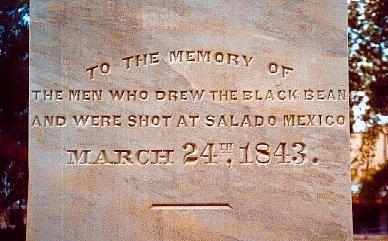 |
|
In
New Orleans, Sam publicly vowed revenge against Santa Anna before
returning to Texas
in January 1844, where he rejoined Jack Hays. Due to the Republic’s
wretched financial condition, Hays’s company of Texas Rangers had
been reduced to only 25 men and was about to be disbanded altogether
until President Sam
Houston provided limited funding. However, more important than
the money was Houston’s
authority for Hays to take possession of the Texas Navy’s supply
of Colt
Paterson revolvers.
The five-shot, .36 Caliber Colt Paterson was unique in appearance,
with no trigger guard and a trigger that appeared only when the
hammer was cocked. Although the weapon was fragile, it was the world’s
first successful cap and ball percussion revolver and revolutionary
in its design. Armed with two repeating Colts and an extra cylinder
for each weapon, the Texas Rangers for the first time were more
than a match for the Comanches on horseback.
Sam Walker helped prove the worth of the Paterson in June of 1844,
when he rode with Jack Hays at the Battle
of Walker’s Creek (not named for Sam). During a running fight
on horseback, the Comanches suffered 23 dead and 30 wounded compared
to the Rangers who had only one dead and four wounded. The victory
was widely reported, and the Texas Rangers and their Colts became
famous. Unfortunately the publicity came too late to save Sam Colt.
His business had gone bankrupt in 1842.
|
|
|
Samuel
Colt
19th Century Engraving
wikipedia |
|
After
Jack Hays resigned from active Ranger service in August 1845, Sam
Walker rode for a time with his good friend Ad Gillespie’s Ranger
Company. However, with the dawn of the Mexican American War, Sam
arranged for a meeting with General Zachary Taylor headquartered
in Corpus
Christi at the mouth of the Nueces River. Walker offered his
services to a United States Army facing an unknown enemy in unfamiliar
country, stating to Taylor that his men knew both the Nueces Strip
where the fighting was likely to begin, and the Mexican cavalry
with whom they had been skirmishing for years.
In 1845, the United States Army did not have a cavalry branch. Instead,
General Taylor was authorized mounted infantry referred to as dragoons.
Dragoons rode to battle, but they were trained to dismount and fight
on foot when they engaged the enemy. Taylor soon learned his dragoons
were a poor substitute for cavalry when sixty of them were easily
captured by the highly mobile and well-mounted Mexicans. As a result,
Sam Walker was given authority to raise the Texas Mounted Rifles.
During the remainder of the war, Walker’s men, and later the Texas
Rangers would serve as the army’s cavalry.
General Taylor called on Walker's Texas Mounted Rifles to keep his
lines of communication open between the army and the supply depot
at Port Isabel,
and between him and the small detachment at Fort Brown on the Rio
Grande across from Matamoras. The Mounted Rifles accomplished their
mission, and more importantly, discovered that Mexican General Ampudia
had crossed the Rio Grande with the main part of his army and was
preparing to launch a surprise attack on the unsuspecting Americans.
Making a daring night ride directly through Mexican lines, Sam Walker
and his men arrived in time to warn Taylor, and the General’s forces
were waiting for Ampudia’s army at Palo Alto, a thorny, chaparral
covered plain north of the Rio Grande. The Americans won the day
after a hard fought battle, and then routed the Mexicans the following
day at Reseca de La Palma, a dry lake a few miles south of Palo
Alto. Ampudia was forced to retreat across the Rio Grande. The fame
of the Texas Rangers spread far and wide, and Sam became celebrated
as a national hero.
|
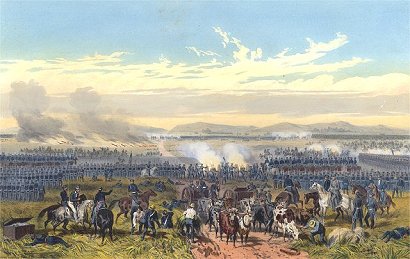 |
Battle
Of Palo Alto, Painting by Carl Nebel
Wikimedia Commons |
|
In
June 1846, Walker was appointed a regular Captain in the United
States Army and authorized to raise a volunteer company. However,
he served as a Ranger until his enlistment was up in October when
he and Jack Hays returned to San
Antonio from Mexico. After a whirlwind of parties and banquets
held in their honor, the Rangers sailed for New Orleans. The duo’s
arrival in Louisiana created a sensation and they were received
as honored visitors. From New Orleans, the Rangers went their separate
ways, with Jack Hays heading for Mississippi and Sam for Washington
D.C. to recruit, equip, and train his new command. Walker spent
the next six months in the east raising money to buy arms and equipment.
In November, Walker met with Samuel Colt in New York and the two
men soon became good friends. The bankrupt inventor also found an
enthusiastic buyer for his invention, but Sam pointed out that the
Paterson had a few problems and offered some solutions. First, he
said the Patterson was too fragile and the emerging trigger was
more suited to a parlor gun than a working weapon. The need to remove
the barrel before reloading was also a serious drawback. Eager to
make a sale, Colt readily agreed to everything Sam suggested and
added a few additional improvements on his own.
The result was the most powerful handgun ever made, until the introduction
of the .44 magnum revolver more than a hundred years later. The
six-shot “Walker” Colt had a longer cylinder than the five-shot
Paterson, capable of holding a greater charge of powder. The revolver
was manufactured in .44 caliber rather than .36, and it had a lever
attached underneath the nine inch barrel for easy reloading. With
a standard trigger and guard, the weapon weighed in at nearly five
pounds, but the big revolver was as accurate as a rifle out to 200
yards. Truly a weapon made for the Texas Rangers.
The next step was to convince the government to purchase the powerful
handguns in sufficient quantity to justify their manufacture. Sam
Walker went straight to the top. Traveling to Washington D.C. in
January 1847, he relied on his new found fame to secure a personal
meeting with President Polk. When the now celebrated Texas Ranger
explained the need for the new revolver, the President immediately
ordered his Secretary of War to purchase 1,000 “Walkers” at twenty-five
dollars each. Sam Colt contracted with Eli Whitney to manufacture
the weapons. The Walker Colt’s adaptability to Texas Ranger style
warfare would forever change the way in which mounted men fought.
|
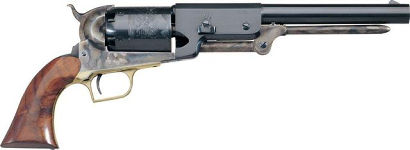 |
"Walker"
Colt Model 1847
Wikimedia Commons - Author Older Firearm |
|
While
the new Colts were being manufactured, Sam Walker’s Company C, First
U. S. Mounted Rifles boarded ship and arrived at Vera Cruz on May
10, in time to join General Winfield Scott’s invasion of Mexico.
The first shipment of Colts arrived in June, but they sat crated
and forgotten in a Vera Cruz warehouse. Meanwhile, the men of Company
C fought their way inland as far as Perote to gain a foothold for
Scott’s army beyond the support of the Navy’s guns.
Although they were officially a part of the United States Army,
as far as Walker’s men were concerned, they were Texas Rangers.
This assertion ruffled the feathers of many regular army officers,
but the Texans silenced their critics by distinguishing themselves
far beyond any other unit in Scott’s army. Engaging both Mexican
army units and guerrillas, the Texans skirmished with tenacity and
skill, provided intelligence, and kept General Scott’s supply lines
to Vera Cruz open.
On
October 4, Walker, as usual, was riding at the head of General Joseph
Lane’s Division when a courier delivered a personal gift from Sam
Colt; two engraved “Walker” Colts. He and his men had fought for
the first few months using personal and army issue weapons, and
thanks to an inept supply system, the Colts still languished on
the Vera Cruz docks.
General Scott, having attacked and occupied Mexico City, was pressing
General Lane to advance on Puebla where a small American force was
besieged by 4000 Mexicans under the personal command of Santa Anna.
After conferring with Walker on October 8, Lane decided to attack
the Mexican advance force at Huamantla. The Rangers would lead the
assault, and with an obsession to capture Santa Anna, Sam Walker
would have had it no other way.
The following morning, Lane ordered Sam to remain within support
distance of his main force as he began a cautious approach on the
small town. Within minutes Walker’s scouts reported the Mexicans
deploying to ambush General Lane’s approaching troops, and disregarding
Lane’s order to stay close, Sam immediately ordered his 250 Rangers
to attack a weak point in the enemy’s lines. The Rangers drove deep
into the Mexican lines, but their lightning advance left them open
to a counterattack by Santa Anna. Fighting became close and vicious
with no quarter being asked or given by either side.
|
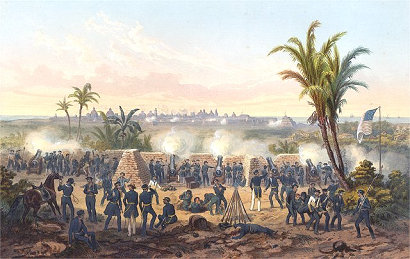 |
Battle
Of Vera Cruz, Painting by Carl Nebel
Wikimedia Commons |
|
When Lane and
his reinforcements arrived, nearly an hour after the fight had started,
the enemy was in total disarray. The Mexicans suffered 461 casualties
during the intense battle and the Rangers had 47 wounded and 27
dead, among them Sam Walker. Though he had been killed, his victory
over Santa Anna was complete. The remainder of the Mexican troops
at Huamantla fled the field, only to be hunted down like animals
over the next two days by the vengeful Rangers, many of whom were
Sam’s long-time friends from Texas. Santa Anna somehow managed to
elude the Texans and ended up exiled in Jamaica, but his government
was shattered.
On October 12, General Lane moved his forces into Puebla, breaking
the siege, and most of the regular Mexican Army units ceased hostilities.
However, guerilla activity continued against Scott’s supply line
to Vera Cruz until the arrival of a regiment of Texas Rangers under
the command of Jack Hays. Finally putting the “Walker” Colt to the
use Sam had envisioned, the Rangers devastated the guerillas with
the weapon’s overwhelming firepower.
The War with Mexico officially ended with the signing of the Treaty
of Guadalupe-Hidalgo on February 2, 1848. Sam Walker’s fame had
spread far and wide by the end of the war, and his passing was headline
news in every newspaper in America. Walker’s body was returned to
San Antonio for burial.
© Jeffery
Robenalt
"A Glimpse of Texas Past"
July
1, 2012 Column
jeffrobenalt@yahoo.com
References
›
About Jeffery Robenalt ›
|
References
for "Sam Walker Texas Ranger and the “Walker” Colt"
|
|
Bauer, Jack
K. ; Johannsen, Robert W. (1992), The Mexican War, 1846-1848,
New York: Macmillan.
Dunn, Betty,
Texas Ranger Samuel H. Walker, Texas Center for Regional
Studies, www.texascenterforregionalstudies.com/texas-ranger-samuel-h-walker,
retrieved April 10,2013.
Hosley, William
(1996), The Making of an American Legend, University of Massachusetts
Press, ISBN 979-1558490437.
Levinson, Irving
(2005), Wars within Wars: Mexican Guerrillas 1846-1848, Fort
Worth, TX: Texas Christian University Press.
Nieman, Robert,
Texas Ranger Dispatch Magazine, Issue 9, Winter 2002, http://texasranger.org/dispatch/9/Walker.htm
[4/30/2009], retrieved April 10, 2013.
Spurlin, Charles
D., Walker, Samuel Hamilton, Handbook of Texas Online, http:/tshaonline.org/handbook/online/articles/fwa23,
retrieved March22, 2013, Published by the Texas State Historical
Association.
Witt, Gerald,
The History of Eastern Kerr County, Austin, Texas, Nortex
Press, 1986, pp. 100-106.
The Occupation
of Mexico, May 1846, July 1848,
http:/history.army.mil/brochures/occupation.htm , retrieved April
10, 2013.
|
|
|
